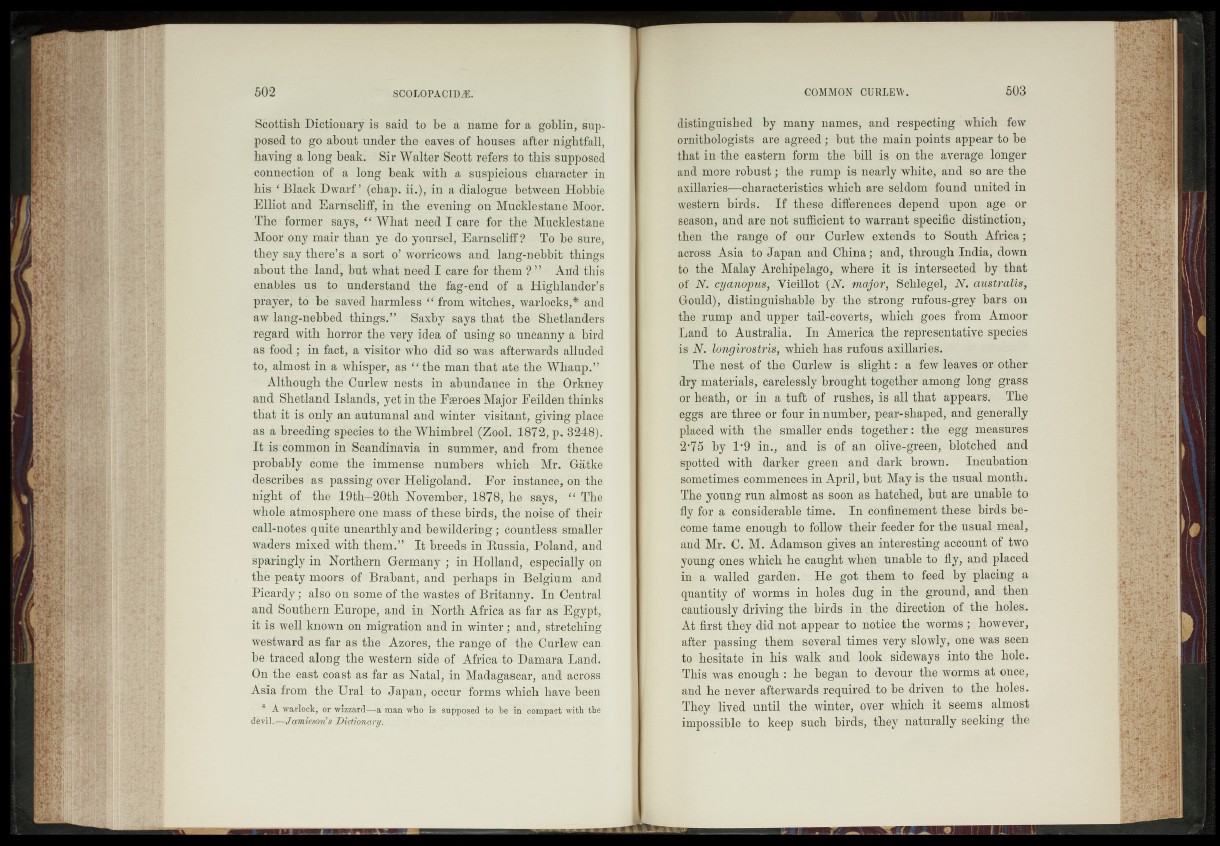
Scottish Dictionary is said to be a name for a goblin, supposed
to: go about under the eaves of houses after nightfall,
haying a long beak! Sir Walter Scott refers to this supposed
connection of a long beak -with a suspicious character in
his ‘Black Dwarf’ (chap. ii.}/in. a dialogue between Hobble
Elliot and Earnscliff, in the evening on MucElestane Moor.
Thé former says, “ What heed I care for -the'Mucklest’ane
Moor onymair than ye do yoiirsel,’ Earnscliff? To be-sure,
they say there’s a sort o’ worricows and lang-nebbit things
about the . land, but what peed I care for them • And this
enables us to understand the fag-end of a Highlander?s
prayer, to be saved harmless “ from witches, warlocks,* and
aw lan'g-nebbed things.”. ■ Saxby says that the' Shetlanders
regard , with horror the very idea of-‘us-ing^so "uncanny a bird
as food; in fact, a visitor who "did :so was afterwards alluded
to, almost in a whisper, as “ the man that ate’the* Wliaup.”
Althoughfthe* Curlew nestsrin abundance in, the Orkney
and Shetland Islands, y e t in the FggroesMajbr Feilde'nfhmks
that; ifc is only an autumnal and winter ^visitant, giving placé
as a breeding species to theWhimbrel (ZooLl’872, p. 3248).
It is common’in Scandinavia in summer,* and from' thence
probably come the immense- numbers'' jwhich.' Mr. -!Catke
describes as passing over'Heligoland. For instance; oh^ffie
night of the 3,9th4-20th November, r1878, he says, :4f?The
whole atmosphere one' mass ofl&hes# birds; the n&sel'of their
call-notes quite unearthly-and bewildering ^countless! smaller
waders mixed with them.” It breeds in Russia;, Poland; and
sparingly in Northern .Germany ; in'Holland, 'especially on
the peaty moors of- Brabant, and perhaps in Belgium -and
Picardy; also on some ofë|J|é wastes of Britanny. Tn Central
and Southern Europe, and North Africa as;far astS^yp^
it i s well known on migration and in winter; and, stretching
westward as far as the Azores,* the range of ^’thé^Curlew« ban
be-traced along the western- side«^Africa!to Damara Land.
On the east coast as far as Natal, in-Madagascar, and:*acro'ss
Asia from the Ural- to-Japan, occur'foi.%Ssr?wbich «bave'hëen
■ * A warlock; or wizzard—a man who ïs-’“süpposed to^B”^ in i coï&pact 'witlf^hê
s Dictionary.
distinguished by many names, and respecting which few
ornithologists are agreed ; but the main points appear to be
that in-the eastern form the bill is. on! the average longer
and more robust the rump is nearly white, and so are the
axillaries—characteristics which are seldom found united in
Western birds. If these differences depend upon age or
season, and are not sufficient to warrant specific distinction,-
then the rangé of our Curlew extends to South Africa ;
across Asia, to Japan and China ; and, through'India, down
tm thé Malay'Archipelago, where it is intersected 'by that
Qf*fflï;,cÿanopu8, Vieillot -(2V!" ma jot, '-ScMîegel, - 'Ns australis,
Gould), distinguishable-by* the strong rufous-grey bars on
the- rump and'upper tail-coverts, which goes'from Amoor
Land* to Australia. In America the representative species
is W•■‘hngimsiriSy which has rufous axillaries. i
The nest of the Curlew is slight : a i few leaves or; other
dry materials, carelessly brought together among long grass
c£ heath, or in a tuft of rushes, is all that appears. The
-eggs are three or four in number, pear-shaped, and generally
placed with the-!smaller-ends together; the- egg- measures
2*75 by 1*9 in., and is of an olive-green, blotched", and
spotted with darker green and dark nteown. Incubation
Sometimes commencés in April, but May is the usual mouth,
ithe young run almost as soon as hatched, but are unable to
fly for a considerable time. In confinement these birds become
tame enough to follow their feeder for the Usual meal,
ahd'Mi\-C.;:M. Adamson'gives an interesting account of. two
young-ones which he caught when Unable „to. fly, and. placed
in a walled gar dén.- He got them to feed ,hyf placing a
-quani^ty'.pf. worms in holes .dng in the ground, and--then
cautiously! driving >the birds in ,the direction ofpthe holes.
At first they-did not appear to* notice;th<3 worms ; . how^vér;
after* passing, them sèveral times.-veryrslowly,* one was seen
to hesitate£-in his walk" and look’ sideways into the hole,
Jflhis was ehoUgh x he began to deyour the worms at-once,
and h^|nevcr afterwards required be driven to the boles.
;|phey- lived .until the winter, over which it seems almost;
impossible, to keep such birds, they naturally‘seeking the